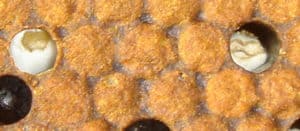When I started inspecting for honey bee diseases, the first and most prevalent disease I found was chalkbrood. I first observed this disease a few weeks into the spring while inspecting a few colonies. I had seen the disease on several other occasions, so it was very easy to identify by the hard “chalk-like” mummies inside the cells. As the season progressed, I learned something from the bees and what they do when the colony has chalkbrood. The nurse bees will drag white, black and other different colored infected larvae out of the hive. These “chalk-like” mummies can be found around and in front of the entrance.
Ascosphaera apis is the fungus responsible for this bee disease. Over 20 species of chalkbrood have been discovered in North America. The true origin of chalkbrood is unknown, but most likely arrived from Europe with Megachile rotundata, the Alfalfa leafcutter bee. This species was introduced to assist with pollination demands in the United States. So you may ask, “How do honey bees become infected with chalkbrood?” Worker larvae are infected when fed pollen and honey contaminated with the spores. The spores quickly germinate and the vegetative state of the fungi will out compete the larvae for food. The larva eventually starves and develops into a chalk-like mummy.

One common way to treat is to re-queen, which may or may not clear up chalkbrood. Below I have created a gallery of images showing the various stages of chalkbrood.